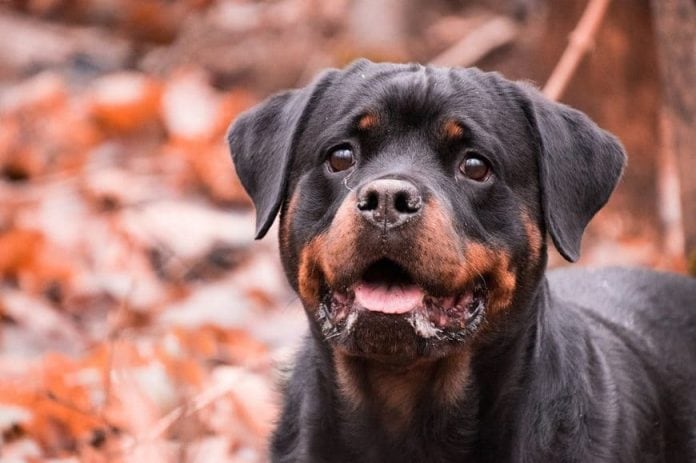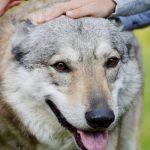You might be thinking of getting a Rottweiler. But if it’s your first time considering this dog, you might find the breed a bit intimidating. Rotties are often seen as terrifying because of their laser focus and bulky build. But on a positive note, they are often the top choice for people who want the best guard dog.
If you are eager to adopt a Rottie, but want something that isn’t as intimidating as a large one, you may consider a miniature or a smaller version of this large dog. Read this post to meet the mini Rottweiler and see if it’s the pet you are looking for.
Origin
The mini Rottweiler is not another breed. Although mini Rotties are quite popular, they are not recognized as their standard counterparts. There are three different ways of coming up with miniatures, and these are as follows:
Cross-mixing – this is done by pairing a Rottie with something much tinier like those dogs with remarkably small pedigree. For example, there are Rotties being paired with compact breeds like French Bulldogs, Corgis, and Beagles. It might look weird but a dog as large as a Rottie is sometimes paired with a small one like a Chihuahua. The health of the offspring will also depend on the health condition of both parent breeds.
Pairing with a runt – instead of pairing with another breed, some Rotties are paired with dogs from the same breed but these are the smallest of the litter, also called the runts. This is another way most breeders do when trying to come up with a miniature version of a purebred dog. While this practice is pretty common, there are a few health concerns involved in using runts. Because of their underdeveloped immune systems, handling runts requires the utmost care.
Dwarfism – The last option breeders have is dwarfism or using a dog with a dwarf gene in developing the litter. There are some who breed dwarf dogs to come up with much smaller litter but this comes with big health risks. If you want to find out if a dog is suffering from dwarfism, you may ask your vet for x-rays and laboratory results. Caring for a dog with many health problems will also require frequent trips to the vet, so it will be more costly for the pet owner.
Appearance
A mini Rottweiler stands 15 inches on average and weighs a maximum of 35 lbs when full-grown. This is three to four times smaller than the standard size of a typical Rottie, which can grow up to 27 inches and as heavy as 130 lbs at maturity.
Mini Rottweilers only differ from their purebred counterparts in terms of size. However, in terms of looks, especially their coat color, you can expect little to no differences. They are known for having that iconic black color with tan points. The only difference is that they act like puppies forever, but with the same fierce look of a Rottie!
Like the big ones, the minis have a short and smooth coat that feels soft to the touch. This makes them easy to groom and clean, an advantage if you are a busy parent. They also do not need frequent baths. In the first place, Rotties are not really a water-loving breed despite their dense coat. An active mini Rottie can be given a full bath every two weeks to keep them from shedding.
Personality
Like their larger counterparts, minis can be trusted with protecting their owners. The dog’s guiding abilities come naturally, since Rotties were originally bred to guard livestock. It is worth noting that these dogs come from the working class. This also makes them suitable for dog competitions on top of being companion animals or family dogs.
You should give your Rottweiler something to do to keep him happy, otherwise, he could develop bad habits and resort to biting and chewing out of boredom. Your Rottie will enjoy playing games of fetch or doggie puzzles, aside from exploring the world around him.
Despite being naturally active, Rotties also have lazy times and that is true even with the miniature versions. They will appreciate time with their owners, like lying on the couch. These dogs just look fierce and strong but they are actually calm especially when trained and socialized early in life. Their affectionate nature will please any “hoomans.”
Grooming
Maintaining the coat of a mini Rottweiler involves brushing him seven times a week with a curry brush. To finish the grooming session, you can follow it up with a soft bristle brush which is suitable only for the Rottweiler’s flat coat. It is important to use a brush with soft bristles to avoid hurting the dog’s skin.
Daily grooming, in addition to regular vacuuming, also keeps your pet’s dead hair from accumulating on the furniture and floor. Part of caring for Rotties involves cleaning their deep muzzle which is thick and easily attracts bacteria due to the excess saliva that might get trapped on their jaws. Consider wiping it with a soft cloth from time to time.
Health
A Rottweiler has a lifespan of only 8 to 11 years. The life of a mini Rottie can be longer or shorter than the average depending on the situation. Obviously, there are risks involved in downsizing naturally large breeds so you cannot have the certainty that mini Rotties bred with much smaller breeds will live longer. Here are a few things to be aware of if you are thinking of bringing home a miniature version of the Rottie:
Achondroplasia – Rotties do not naturally acquire the dwarfism gene and they are not predisposed to abnormal bone growth. Achondroplasia rarely occurs in breeds like Rotties but it does not mean it is not impossible to happen to them. Having Achondroplasia may have a negative impact on the dog’s development and growth.
Progressive Retinal Atrophy – these are groups of eye problems that can lead to total impairment of the ability to see in dogs. The initial symptom is difficulty seeing clearly at night, which is medically termed as nyctalopia. As PRA progresses, the dog will eventually find it hard to see well even at daytime. To determine if a dog is suffering from PRA, he needs to go through a general ophthalmic exam. If the tests show that the dog’s pupils are dilated, it is likely a case of PRA.
Cataracts – another eye problem often seen in this breed is cataract or the occurrence of opacity in the lens. As with humans, this results to cloud-like appearance in the dog’s vision. More often than not, canine cataracts require little to no treatment because most cases are not that severe. Surgical correction is only needed if the cataract has grown larger.
Hip dysplasia – it is pretty common in large dogs but even medium-sized dogs can be affected by hip dysplasia or the displacement between the thigh bone and the hip joint. As a naturally active breed, it is unusual for Rotties to become lethargic at all times. Hence, it is easy to spot if a mini Rottie is going through symptoms of hip dysplasia. Before getting your dog from your prospect breeder, make sure the parents were tested for hip dysplasia to confirm if there is a possibility that they might pass it on to the offspring.
Feeding
The amount you should feed your dog should suit his weight, lifestyle, activities, and current health condition. For example, a mini Rottie weighing 30 lbs can consume up to one and a half cup of dry dog food per day. You can divide this into two feedings per day because it is not healthy to give one large feeding per day. This can cause bloating or twisting of the stomach which can be a pretty serious case in the long run.
To prevent obesity or bloating, consider feeding your pup with an interactive feeder. This puzzle-like bowl for dogs is recommended for fast eaters or those with a tendency to gobble down more than they should. When feeding your buddy, it is important to help him slow down so he can digest the food better.
Exercise
Rotties usually need a lot of room for roaming and playing around. That is one of the many natural characteristics of the breed. But in the case of miniatures, you don’t have to worry about having a large yard. What matters is for these dogs get to have daily exercise. If you don’t have a large space at home where your pup can play, just make sure you take him with you outdoors on a regular basis.
In general, dogs benefit from getting along with other dogs. Socialization is one of the keys to their proper development, so it would help to bring the dog to a puppy park or enroll him in puppy classes where he could meet and interact with other dogs.
Important reminders before getting a Mini Rottie
Be careful about breeders selling “purebred” miniature Rotties. Rottweilers are known for being large breeds, so if you ever find a mini one, it has been either bred using much smaller pedigrees or even using dwarfism. As we mentioned above, it might be risky to downsize dogs especially if there’s dwarfism involved in breeding them. The best type you can get is a mixed breed or the offspring of a healthy Rottie paired with another breed in top shape.
Conclusion
A mini Rottie is the perfect pet for people who want a good watchdog or guide dog, but want something that is not too large to fit in any household. Obviously, the large and bulky Rottie is not for everyone. It is not even recommended for first time pet parents. But with something much smaller, you can have the confidence your buddy can fit in any environment, be it a small house or an apartment.






















